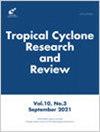Can one reconcile the classical theories and the WISHE theories of tropical cyclone intensification?
IF 4.1
4区 地球科学
Q3 METEOROLOGY & ATMOSPHERIC SCIENCES
引用次数: 0
Abstract
An effort is made to reconcile the classical balance theories of tropical cyclone intensification by Shapiro and Willoughby and Schubert and Hack and the various prognostic (or WISHE-) theories of Emanuel. As a start, it proves insightful to extend the classical theories to account for explicit latent heat release in slantwise ascending air. While such an effort uncovers enroute a range of old modelling issues concerning the representation of deep convection in a balance framework, the analysis provides a new perspective on these issues. The bottom line is that the two theories cannot be reconciled.
The behaviour of the classical model with explicit latent heat release included is illustrated by a particular calculation starting with an axisymmetric vortex in a conditionally-unstable atmosphere. As soon as condensation occurs aloft, the moist Eliassen equation for the overturning circulation becomes hyperbolic in the convectively-unstable region and the model cannot be advanced forwards beyond this time unless the Eliassen equation is suitably regularized to remove these hyperbolic regions. However, regularization suppresses deep moist convection, leaving no mechanism to reverse the frictionally-induced outflow in the lower troposphere required to concentrate absolute angular momentum there. For this reason, the initial vortex spins down, even following the formation of elevated cloud with the accompanying latent heat release.
The fact that the flow configuration in the explicit moist version of the classical theories is similar to that in the WISHE theories raises several fundamental questions concerning the physics of vortex spin up in the WISHE theories, calling into question the utility of these theories for understanding tropical cyclone intensification in nature.
关于热带气旋增强的经典理论和WISHE理论能调和吗?
人们努力调和夏皮罗、威洛比、舒伯特和哈克关于热带气旋增强的经典平衡理论和伊曼纽尔的各种预测(或wish -)理论。首先,将经典理论扩展到解释倾斜上升空气中的显性潜热释放,证明了它的洞察力。虽然这样的努力揭示了一系列关于在平衡框架中表示深对流的旧建模问题,但分析提供了对这些问题的新视角。最重要的是,这两种理论不能调和。以条件不稳定大气中的轴对称涡旋为起点,通过一个特殊的计算说明了包含显式潜热释放的经典模型的行为。一旦高空发生凝结,翻转环流的湿润Eliassen方程在对流不稳定区变成双曲型,除非对Eliassen方程进行适当的正则化以去除这些双曲型区域,否则模型无法向前推进。然而,正则化抑制了深层潮湿对流,没有机制来逆转对流层下层摩擦引起的外流,这需要将绝对角动量集中在那里。因此,即使在高架云形成并伴随潜热释放之后,最初的涡旋也会向下旋转。经典理论的明确湿润版本中的流动结构与WISHE理论中的相似,这一事实提出了几个关于WISHE理论中涡旋上升物理学的基本问题,并对这些理论在理解自然界热带气旋增强方面的效用提出了质疑。
本文章由计算机程序翻译,如有差异,请以英文原文为准。
求助全文
约1分钟内获得全文
求助全文
来源期刊

Tropical Cyclone Research and Review
METEOROLOGY & ATMOSPHERIC SCIENCES-
CiteScore
4.60
自引率
3.40%
发文量
184
审稿时长
30 weeks
期刊介绍:
Tropical Cyclone Research and Review is an international journal focusing on tropical cyclone monitoring, forecasting, and research as well as associated hydrological effects and disaster risk reduction. This journal is edited and published by the ESCAP/WMO Typhoon Committee (TC) and the Shanghai Typhoon Institute of the China Meteorology Administration (STI/CMA). Contributions from all tropical cyclone basins are welcome.
Scope of the journal includes:
• Reviews of tropical cyclones exhibiting unusual characteristics or behavior or resulting in disastrous impacts on Typhoon Committee Members and other regional WMO bodies
• Advances in applied and basic tropical cyclone research or technology to improve tropical cyclone forecasts and warnings
• Basic theoretical studies of tropical cyclones
• Event reports, compelling images, and topic review reports of tropical cyclones
• Impacts, risk assessments, and risk management techniques related to tropical cyclones
 求助内容:
求助内容: 应助结果提醒方式:
应助结果提醒方式:


